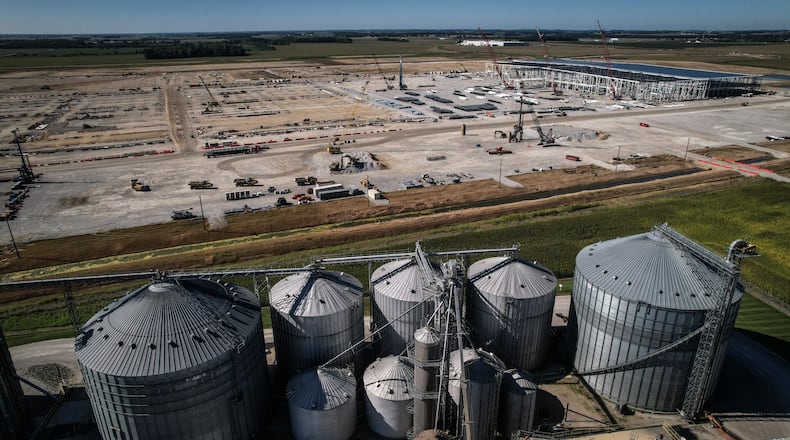“Without a doubt, hands down,” Luebbe said in an interview Tuesday. “Fayette County really hasn’t changed much in the 25 years that I’ve been here, or probably in the 25 years prior to that.”
He estimated that the county and its partners, including contractors and neighboring governments, are pursuing more than $100 million total in road, water, and electric infrastructure improvements for the enormous plant located in Northwestern Fayette County.
In a couple of years, the joint venture Honda-LG Energy factory that will cover the equivalent of 78 football fields is expected to be producing EV batteries for American-made Honda automobiles.
Credit: Jim Noelker
Credit: Jim Noelker
The plant is expected to employ about 2,200 people. It will be an approximately 50-minute drive southeast of Dayton and about 40 minutes south of Springfield.
The leaders of the joint venture expect to pull workers from those communities and others.
“People realize this is not just Fayette County,” Luebbe said. “It’s all of Ohio.”
While this kind of development is new to rural Fayette County, it is not new to Ohio.
Starting in the late 1970s, Honda transformed the then-quiet Marysville area as it built first a motorcycle plant then a 3.6-million-square-foot auto assembly plant.
“We’re kind of looking at the Marysville area as sort of a pattern,” Luebbe said. He notes that dozens of Honda suppliers are near Honda’s Marysville facilities, in central Ohio, northwest of Columbus.
“The whole area gets kind of filled up with that,” he said. “And it’s not just Honda suppliers. But we certainly see this as a catalyst to develop that (Fayette County) site and probably the surrounding area.”
In time, Luebbe expects to see Honda suppliers in his county, as well as other businesses — and probably new housing, as well.
“I think this is going to be a catalyst for change out there,” he said. “How fast and how much, I’m not sure.”
The work falls across four dimensions — roads, electric, sewer and water.
Plans call for Bluegrass Boulevard to extend to what Luebbe calls the “megasite” — his term for the 2,500-acre industrial site — connecting eventually with Ohio 41 to the north and Ohio 435 to the south.
The work will see the county’s first roundabout, tying Bluegrass to the EV battery plant, with the roundabout intersection sitting about a half-mile west of the plant.
When work is finished, Bluegrass will act as an “arterial,” Luebbe said, offering access between Ohio 435 to 41, parallel to Interstate 71. “It provides a nice transportation network for the whole area.”
The county is also improving a wastewater treatment plant, building a water treatment plant and adding a water tower.
Credit: Jim Noelker
Credit: Jim Noelker
In fact, most of the work is water-related, Luebbe said, with water work accounting for some $80 to $100 million in construction. The work involves extending water lines and building the water treatment plant.
The county will build a raw water transmission main to tap into Wilmington’s line, which draws water from Caesar Creek Lake before treating it. The county will tie into that line where it crosses I-71.
The project required the cooperation of Wilmington and the U.S. Army Corps of Engineers.
The option is better than expanding wellfields or building a new reservoir. “There’s a lot of available water in Caesar Creek Lake,” Luebbe said.
It’s not just public entities scrambling to accommodate the new plant. AES Ohio said it will build 13 miles of 350-kilovolt power lines, with 2.5 miles of a 69-kilovolt line, a pair of new substations for transmission while relocating a distribution substation.
“This whole site is going to be a catalyst for change,” Luebbe said. “And we think it’s going to be a good change.”
About the Author



